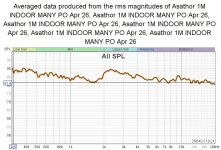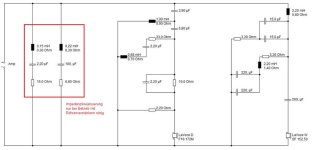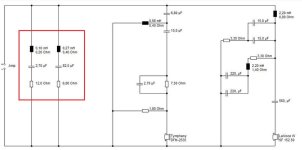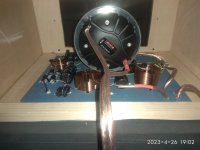Ihave measure all the crossover parts.
I have duble check all the connections.
Here is a new indoor average measurement with the UMIK1 at 1m in multy positions on axis & off axis .
Smoothing 1/24.
I have duble check all the connections.
Here is a new indoor average measurement with the UMIK1 at 1m in multy positions on axis & off axis .
Smoothing 1/24.
Attachments
Last edited:
For electrical mesurement as Tom K. suggested, you can leave the speakers connected and wire the ADC (Soundcard in) in parallel with the speaker, so you have the same resistor value at the output. This shows you the voltage at the speaker, which can be quite usefull. Do not turn up the amp too much, most soundcards have a 5V limit. So an input voltage (input of x-over) of 2V RMS should be fine, Measure with a generator frequency around 200 Hz, use the AC setting of your multimeter.
The clamps are attached in parallel to the driver:

Which is then attenuated and limited in the aluminum box with the large 'gold' resistors (which are out of the circuit). You don't have to have that if you keep the level low enough.
Then the signal is going into the USB audio interface:

Input 1 is an actual microphone, which is not necessary. The second input is the signal across the driver.
This could also be helpfull: https://www.diyaudio.com/community/threads/efficient-2-way.380822/post-7307110
It allows measuring the driver only as the driver input is taken as a reference. That is what I was doing when I took the pictures btw.
The software is just REW. It doesn't care if the signal comes from across the driver or from a microphone.


Which is then attenuated and limited in the aluminum box with the large 'gold' resistors (which are out of the circuit). You don't have to have that if you keep the level low enough.
Then the signal is going into the USB audio interface:

Input 1 is an actual microphone, which is not necessary. The second input is the signal across the driver.
This could also be helpfull: https://www.diyaudio.com/community/threads/efficient-2-way.380822/post-7307110
It allows measuring the driver only as the driver input is taken as a reference. That is what I was doing when I took the pictures btw.
The software is just REW. It doesn't care if the signal comes from across the driver or from a microphone.

I think that i found the problem....
I have used the LAVOCE DF10.172M horn driver with the wrong values crossover parts!
First picture is crossover parts for the LAVOCE horn driver.
Second picture is crossover parts for the Tymphany.
I have used the LAVOCE DF10.172M horn driver with the wrong values crossover parts!
First picture is crossover parts for the LAVOCE horn driver.
Second picture is crossover parts for the Tymphany.
Attachments
Last edited:
Of course, that explains a lot.
Also, the coils should not come close to the magnet of the compression driver. This influences the coil value enormously, since the coil generates a magnetic field during operation and this is of course significantly changed by the permanent magnet.
Nico Germanos, the head of the German Tymphany sales department, confirmed this to me personally and for this reason he had to take some of his kits out of the store, because he cannot sell as many of them as he would have to buy from Tymphany.
Also, the coils should not come close to the magnet of the compression driver. This influences the coil value enormously, since the coil generates a magnetic field during operation and this is of course significantly changed by the permanent magnet.
There is a simple explanation for this. Tymphany produces many of the current drivers only when a certain quantity is purchased, because the cost of raw materials is very high. Therefore, there are currently very long waiting or delivery times.Third, the drivers may be out of spec. For some reason Tymphany does not like to sell the the compression driver any more. This makes me think...
Nico Germanos, the head of the German Tymphany sales department, confirmed this to me personally and for this reason he had to take some of his kits out of the store, because he cannot sell as many of them as he would have to buy from Tymphany.
Minimum order at digikey is 120 pieces. 39€ + sales tax each. As retailer you get a discount.
TLHP sell 30 units at 36€ sales tax included.
Germanos sells them at 60 € a piece if you buy his x-over parts.
The part is simply to cheap to sell for single unit retailers and Chinese producers are hard to calculate with. They may rise prices today and lower them next week, so your large stock is devalued, while competitors then get lower numbered lot's at even lower prices. Too much risk for a small sales company.
TLHP sell 30 units at 36€ sales tax included.
Germanos sells them at 60 € a piece if you buy his x-over parts.
The part is simply to cheap to sell for single unit retailers and Chinese producers are hard to calculate with. They may rise prices today and lower them next week, so your large stock is devalued, while competitors then get lower numbered lot's at even lower prices. Too much risk for a small sales company.
Last edited:
That is also true. On top of that, as an official distributor, you can't calculate prices at will. Digikey and TLHP are pure middlemen who do not offer any service in case of problems. And you should not underestimate how much working time must be invested in the support of customers after the purchase. Unfortunately, this is often overlooked.
We often forget how small this HIFI speaker DIYS market we are in is. Chinese brands buy a European reputation and then try to sell to much larger domestic markets. No need to respect profit reducing taxes, safety regulations, customer rights and the like, all the stupid rules when you are exporting to serious countries. If you sent 10 units to Europe you have the same problems as if you were exporting 100.000.
In the long term brand name buying does not work. Anyone knows that the real Peerless and Vifa are dead and products, made under their name, are cheap copies from the far east, made by Tympany . Product quality and reputation will sink constandly. Once the last Scandinavian developer has quit, the spirit of a brand is gone and they will be just another OEM serving Chinese company. No need to pay a premium for a Tympany driver because they bought some famous Danish brands decades ago.
The prices they charge today, like other "high end" China brands, which made a name for high value when they started, makes it easys to buy local again, like Seas and Scan Speak.
Small dealers like Quint are nothing important in this game. They take all the risk, do all the work and when this may pay off, the company establishes it's own import branch... nothing new.
In the long term brand name buying does not work. Anyone knows that the real Peerless and Vifa are dead and products, made under their name, are cheap copies from the far east, made by Tympany . Product quality and reputation will sink constandly. Once the last Scandinavian developer has quit, the spirit of a brand is gone and they will be just another OEM serving Chinese company. No need to pay a premium for a Tympany driver because they bought some famous Danish brands decades ago.
The prices they charge today, like other "high end" China brands, which made a name for high value when they started, makes it easys to buy local again, like Seas and Scan Speak.
Small dealers like Quint are nothing important in this game. They take all the risk, do all the work and when this may pay off, the company establishes it's own import branch... nothing new.
The 0.05 ohms are absolutely unproblematic. Such small deviations can always be ignored.
At the store of Quint, there is always a base price for the X-Over components, which refers to the cheapest component of a product series. Each component of the series, which is more expensive, costs a surcharge compared to the cheapest.
Sounds a little complicated, but it's just a quirk of the store.
That's already a bit too negatively portrayed.
Of course, Tymphany is primarily out for profit and takes advantage of the economic benefits of production in the Far East. However, the Vifa or Peerless chassis from Tymphany are not cheap copies, they are manufactured on the original production tools and delivered with comparable quality control as in Europe.
In addition, a lot of effort is put into new products. Not always perfect, but often with very good results. The DA25 and DA32 tweeters are excellent, as are the compression drivers, for which they even poached a highly reputed developer from another major manufacturer.
Quint, based in Germany, is also always involved in the development. So you can see that quality is important and financial resources are also made available for this purpose.
Some Tymphanys are in very, very expensive speakers. I'm not allowed to name them, but there is a loudspeaker on the market that is praised everywhere, costs more than 30000€ and has a 25€ midrange driver from Tymphany in it. And this manufacturer does not use it because it is so cheap, but because it is so good.
So you should not lump everything together. There are also companies in China that produce at a high quality level.
At the store of Quint, there is always a base price for the X-Over components, which refers to the cheapest component of a product series. Each component of the series, which is more expensive, costs a surcharge compared to the cheapest.
Sounds a little complicated, but it's just a quirk of the store.
We often forget how small this HIFI speaker DIYS market we are in is. Chinese brands buy a European reputation and then try to sell to much larger domestic markets. No need to respect profit reducing taxes, safety regulations, customer rights and the like, all the stupid rules when you are exporting to serious countries. If you sent 10 units to Europe you have the same problems as if you were exporting 100.000.
In the long term brand name buying does not work. Anyone knows that the real Peerless and Vifa are dead and products, made under their name, are cheap copies from the far east, made by Tympany . Product quality and reputation will sink constandly. Once the last Scandinavian developer has quit, the spirit of a brand is gone and they will be just another OEM serving Chinese company. No need to pay a premium for a Tympany driver because they bought some famous Danish brands decades ago.
The prices they charge today, like other "high end" China brands, which made a name for high value when they started, makes it easys to buy local again, like Seas and Scan Speak.
Small dealers like Quint are nothing important in this game. They take all the risk, do all the work and when this may pay off, the company establishes it's own import branch... nothing new.
That's already a bit too negatively portrayed.
Of course, Tymphany is primarily out for profit and takes advantage of the economic benefits of production in the Far East. However, the Vifa or Peerless chassis from Tymphany are not cheap copies, they are manufactured on the original production tools and delivered with comparable quality control as in Europe.
In addition, a lot of effort is put into new products. Not always perfect, but often with very good results. The DA25 and DA32 tweeters are excellent, as are the compression drivers, for which they even poached a highly reputed developer from another major manufacturer.
Quint, based in Germany, is also always involved in the development. So you can see that quality is important and financial resources are also made available for this purpose.
Some Tymphanys are in very, very expensive speakers. I'm not allowed to name them, but there is a loudspeaker on the market that is praised everywhere, costs more than 30000€ and has a 25€ midrange driver from Tymphany in it. And this manufacturer does not use it because it is so cheap, but because it is so good.
So you should not lump everything together. There are also companies in China that produce at a high quality level.
I think you are over optimistic. The original Peerless or Vifa tools have long worn out. Have you recently checked how many Tymphany drivers are aviable at the Quint store? I don't see Nico as partner or distributor any more if I search the net. He has only a fraction of the program left and a lot of the listed chassis are not in stock. To me it seems Tymphany has lost interest in the small players of the DIYS market.That's already a bit too negatively portrayed.
Of course, Tymphany is primarily out for profit and takes advantage of the economic benefits of production in the Far East. However, the Vifa or Peerless chassis from Tymphany are not cheap copies, they are manufactured on the original production tools and delivered with comparable quality control as in Europe.
In addition, a lot of effort is put into new products. Not always perfect, but often with very good results. The DA25 and DA32 tweeters are excellent, as are the compression drivers, for which they even poached a highly reputed developer from another major manufacturer.
Quint, based in Germany, is also always involved in the development. So you can see that quality is important and financial resources are also made available for this purpose.
The "new products" are very few and no one noticed. It is much cheaper to copy than to develop. If your country has evolved on a copy culture, it is easy to return to it for higher profits. So as soon as possible you will erase all these excentric developer personal that only uses up money and even want's a noticeable salary.
If you buy a 1000€ speaker, you will find chassis and x-over parts for far less than 100€ inside. So if you pay 25 Euros for a tweeter, the industry pays less than 10€ for it. See, 20% are for sales taxes. 800. 50% for the retailer. 400. 10% for packaging and all transport fees. 360. Minus the chassis leaves 260€.
This small amount has to pay for the factory, machines, tools, energy, workers, development, marketing and lokal taxes, all raw material, paying back credits and investor profits. You see that your 25 € tweeter is quite expensive for a speaker brand?
Maybe you have not noticed how expensive some chassis with a once high price/ value ratio are now. Spell "Wavecore". Maybe the chassis producer want to generate the same profits from DIYS the x-over components do. If that is true, in the future it will be cheaper to buy complete, new speakers and extract the parts from it to use them in your DIYS cabinets. As this is somehow stupid, a small market will get even smaller or vanish at all.
The DIYS market is so small, usual principles for price finding don't work. Prices should drop, not rise more than 30% in one year... talk to me in two years.
If we look at the Asator, if you want to build it, Tymphany is out anyway, better use LaVoce or Red Cat drivers...
I know pretty well how to calculate for loudspeakers. But in your calculation you have totally distorted my example, because instead of the 30000€ I gave you, you just took 1000€.
I also find it funny that you make some claims here and want to explain to me how Tymphany and Quint work, where I have much more inside information. I know Nico for years and have spent countless hours talking to him. Anyone who knows him knows that he doesn't mince words. So you can already believe me when I tell you something.
I don't understand why you're suddenly making RedCatt a topic here either. The brand has no connection to the topic at all, and you can't use it to build an Asathor.
It looks to me like you're only interested in badmouthing Tymphany and Quint. I would therefore ask you not to post any further comments here in this regard. Thanks.
I also find it funny that you make some claims here and want to explain to me how Tymphany and Quint work, where I have much more inside information. I know Nico for years and have spent countless hours talking to him. Anyone who knows him knows that he doesn't mince words. So you can already believe me when I tell you something.
I don't understand why you're suddenly making RedCatt a topic here either. The brand has no connection to the topic at all, and you can't use it to build an Asathor.
It looks to me like you're only interested in badmouthing Tymphany and Quint. I would therefore ask you not to post any further comments here in this regard. Thanks.
- Home
- Loudspeakers
- Multi-Way
- Asathor - a JBL 4367 Clone



